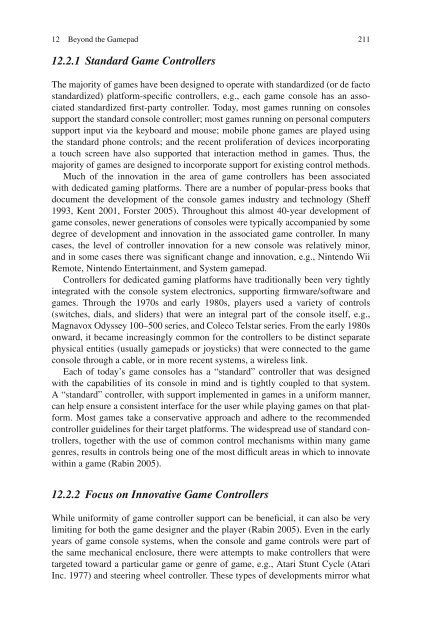Evaluating User Experience in Games: Concepts and Methods - Lirmm
Evaluating User Experience in Games: Concepts and Methods - Lirmm
Evaluating User Experience in Games: Concepts and Methods - Lirmm
You also want an ePaper? Increase the reach of your titles
YUMPU automatically turns print PDFs into web optimized ePapers that Google loves.
12 Beyond the Gamepad 211<br />
12.2.1 St<strong>and</strong>ard Game Controllers<br />
The majority of games have been designed to operate with st<strong>and</strong>ardized (or de facto<br />
st<strong>and</strong>ardized) platform-specific controllers, e.g., each game console has an associated<br />
st<strong>and</strong>ardized first-party controller. Today, most games runn<strong>in</strong>g on consoles<br />
support the st<strong>and</strong>ard console controller; most games runn<strong>in</strong>g on personal computers<br />
support <strong>in</strong>put via the keyboard <strong>and</strong> mouse; mobile phone games are played us<strong>in</strong>g<br />
the st<strong>and</strong>ard phone controls; <strong>and</strong> the recent proliferation of devices <strong>in</strong>corporat<strong>in</strong>g<br />
a touch screen have also supported that <strong>in</strong>teraction method <strong>in</strong> games. Thus, the<br />
majority of games are designed to <strong>in</strong>corporate support for exist<strong>in</strong>g control methods.<br />
Much of the <strong>in</strong>novation <strong>in</strong> the area of game controllers has been associated<br />
with dedicated gam<strong>in</strong>g platforms. There are a number of popular-press books that<br />
document the development of the console games <strong>in</strong>dustry <strong>and</strong> technology (Sheff<br />
1993, Kent 2001, Forster 2005). Throughout this almost 40-year development of<br />
game consoles, newer generations of consoles were typically accompanied by some<br />
degree of development <strong>and</strong> <strong>in</strong>novation <strong>in</strong> the associated game controller. In many<br />
cases, the level of controller <strong>in</strong>novation for a new console was relatively m<strong>in</strong>or,<br />
<strong>and</strong> <strong>in</strong> some cases there was significant change <strong>and</strong> <strong>in</strong>novation, e.g., N<strong>in</strong>tendo Wii<br />
Remote, N<strong>in</strong>tendo Enterta<strong>in</strong>ment, <strong>and</strong> System gamepad.<br />
Controllers for dedicated gam<strong>in</strong>g platforms have traditionally been very tightly<br />
<strong>in</strong>tegrated with the console system electronics, support<strong>in</strong>g firmware/software <strong>and</strong><br />
games. Through the 1970s <strong>and</strong> early 1980s, players used a variety of controls<br />
(switches, dials, <strong>and</strong> sliders) that were an <strong>in</strong>tegral part of the console itself, e.g.,<br />
Magnavox Odyssey 100–500 series, <strong>and</strong> Coleco Telstar series. From the early 1980s<br />
onward, it became <strong>in</strong>creas<strong>in</strong>gly common for the controllers to be dist<strong>in</strong>ct separate<br />
physical entities (usually gamepads or joysticks) that were connected to the game<br />
console through a cable, or <strong>in</strong> more recent systems, a wireless l<strong>in</strong>k.<br />
Each of today’s game consoles has a “st<strong>and</strong>ard” controller that was designed<br />
with the capabilities of its console <strong>in</strong> m<strong>in</strong>d <strong>and</strong> is tightly coupled to that system.<br />
A “st<strong>and</strong>ard” controller, with support implemented <strong>in</strong> games <strong>in</strong> a uniform manner,<br />
can help ensure a consistent <strong>in</strong>terface for the user while play<strong>in</strong>g games on that platform.<br />
Most games take a conservative approach <strong>and</strong> adhere to the recommended<br />
controller guidel<strong>in</strong>es for their target platforms. The widespread use of st<strong>and</strong>ard controllers,<br />
together with the use of common control mechanisms with<strong>in</strong> many game<br />
genres, results <strong>in</strong> controls be<strong>in</strong>g one of the most difficult areas <strong>in</strong> which to <strong>in</strong>novate<br />
with<strong>in</strong> a game (Rab<strong>in</strong> 2005).<br />
12.2.2 Focus on Innovative Game Controllers<br />
While uniformity of game controller support can be beneficial, it can also be very<br />
limit<strong>in</strong>g for both the game designer <strong>and</strong> the player (Rab<strong>in</strong> 2005). Even <strong>in</strong> the early<br />
years of game console systems, when the console <strong>and</strong> game controls were part of<br />
the same mechanical enclosure, there were attempts to make controllers that were<br />
targeted toward a particular game or genre of game, e.g., Atari Stunt Cycle (Atari<br />
Inc. 1977) <strong>and</strong> steer<strong>in</strong>g wheel controller. These types of developments mirror what

















